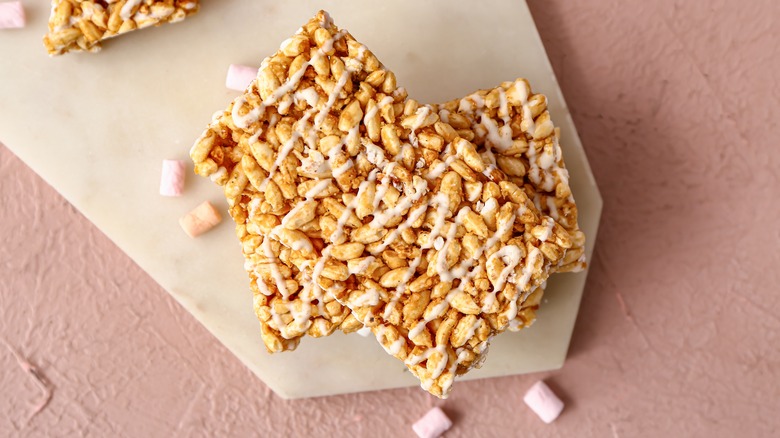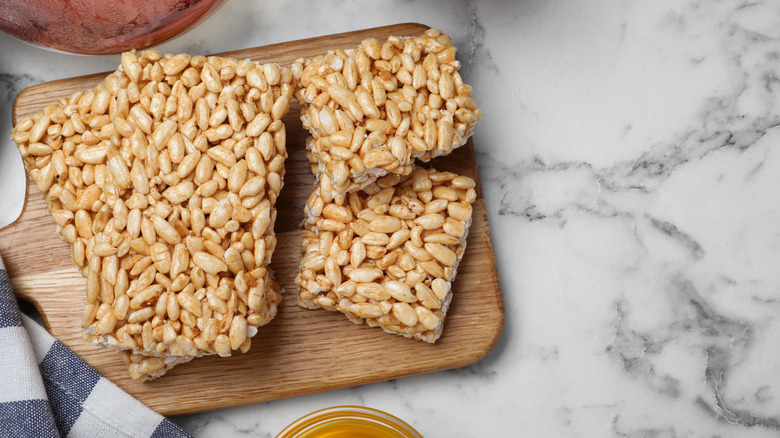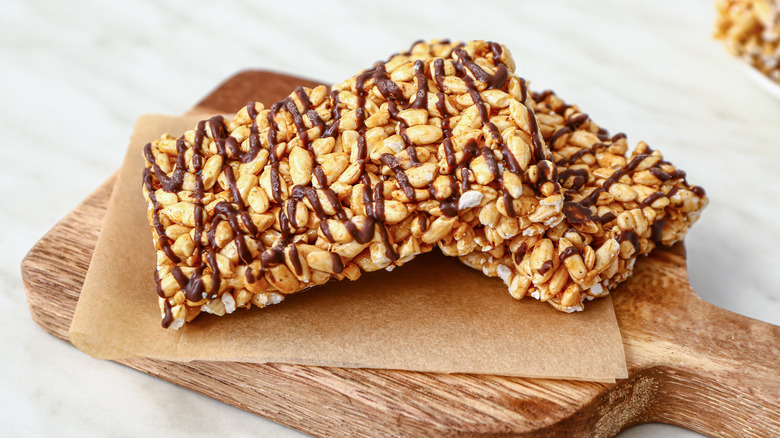For The Perfect Rice Krispie Treats, Don't Skimp On The Salt
Picture this: You're in elementary school and open your lunchbox to see what your mom packed for lunch. You're at a local bake sale and looking for something to buy that stands out from the usual cookies and brownies. You're eating cereal one morning, and you notice a recipe on the back of this cereal box. What do these three scenarios have in common? If you guessed that it has something to do with rice krispies treats, you'd be right.
A staple of children's lunchboxes and charity bake sales, rice krispie treats (sometimes known as the generic name marshmallow squares) are a beloved treat for adults and children alike. The origin of the sticky marshmallow and cereal treat is actually a bit murky, with some crediting Kellogg employee Mildred Day for inventing them back in the early. In contrast, others credit the first recipe to Lucy Maltby in 1938. While the debate over who invented the treats is for another day, it's no secret that rice krispie treats have withstood the test of time.
Why wouldn't this treat be popular? The recipe is straightforward, considering it's mainly Rice Krispies cereal, marshmallows, butter, and ... salt? What benefits could salt bring to something that's supposed to be sticky, sweet, and crispy?
Salt helps to cut the sweetness of the marshmallows
Salt in rice krispie treats does sound like a pretty unconventional ingredient. After all, it would be like we're telling you to put a handful of salt on your morning bowl of Rice Krispies. But let's answer your question with a question: have you ever eaten a rice krispie square and found that, while it was pretty darn good, it was way too sweet? All that melted butter and marshmallows make these squares very rich and sugary, to the point that it feels almost overpowering.
If you've ever had that problem, you'll need a few sprinkles of salt. You can lessen the sweetness by adding salt to the mixture before spreading it out in the pan or by seasoning the finished treats the moment they come out of the oven. The salt also adds a refreshing texture change, giving the squares a crunchiness that complements the soft stickiness you usually find in your rice krispie treats.
The trick here is to find the right balance between keeping the salty flavor subtle so it doesn't taste as though you bit into a salt lick. It's suggested that you start lightly with the salt first and work slowly until you find the right combination.
You can also get a salty flavor without salt
While the idea of eating rice krispie treats that taste both sweet and salty doesn't sound too bad, it's understandable that you may not want to add all that salt to your dessert. How can you get that subtly salty-sweet flavor in your rice krispie squares without adding too much salt?
A great solution would be to use caramel — or, in this case, salted caramel. By adding a few squares of salted caramel candy to the marshmallow mixture or by adding a bit of salt to unsalted caramel and melting it over the stovetop before adding it to the mixture, you can get that same sweet and salty taste. The only downside is the treats may be much stickier than you anticipated, so it's suggested that you let them cool completely before serving.
Another good solution to help cut through all that sweetness is to add brown butter. While not exactly as salty as the salted caramels, the richness and warmth of the brown butter gives the dessert a nuttier, toasted flavor that will help cut through the incredibly sweet taste of the marshmallows.
You can add a wide variety of things to your rice krispie treats, whether you want them to be sweeter, saltier, or have a much more complex flavor.


